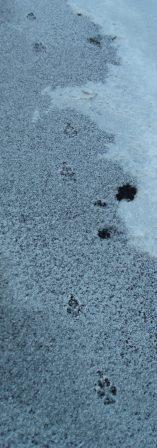by Carl Strang
The gaits I introduced earlier were the basic ones, used by most mammals as they travel. There are others, however, and today I want to feature the trot. A trotting animal steps with its left front and right hind feet simultaneously, then its right front and left hind. The speed is faster than a diagonal walk (in which the animal moves only one of its feet at a time), so the footprints are farther apart. I have noticed two different patterns most commonly associated with the trot.

In the above photo, a coyote passed through a parking lot in the trot gait. Coyotes show this gait more than our other wild mammals (technically the opossum walks in a slow trot, but its peculiar footprints form the gait pattern of a diagonal walk). The footprint pattern of this coyote’s trot is unlike those in the gaits introduced earlier. The tracks appear to be in pairs, as was true for the diagonal walk, but the feet land farther apart. Furthermore, the hind foot is landing in front of the front foot.

Here is a closer look at one of those footprint pairs. In coyotes and other members of the dog family, the front foot is larger than the hind foot, and its heel mark is much wider. The heel of the hind foot has more of a circular shape.
A different trot pattern you may find is this one, provided in this example by a dog.

At first this pattern resembles the diagonal walk, but the pairs of footprints are too far apart, the tracks in each pair are too much side by side (rather than one slightly in front of the other with more overlap), and a close look reveals that all front footprints are to one side (to the animal’s right in this example), and all hind footprints are to the other. This puzzled me until I saw a dog producing the pattern. It was trotting, but as it did so it held its body at an angle to its direction of travel, so its front feet always landed to one side of its hind feet. Sounds odd, but if you watch enough dogs you’ll see it.
Pressure Releases 2: Pivots « Nature Inquiries said,
March 14, 2009 at 11:45 am
[…] of the coyote’s front footprint with its hind foot reveals that the animal had downshifted from its usual trot to a diagonal walk, perhaps because of the soft mud. You can see a tiny sideways slide of the […]
Coyote Tracking « Nature Inquiries said,
December 15, 2010 at 7:07 am
[…] gait is a diagonal trot (for an earlier primer on the trot gait go here). But which way is the coyote facing? A closer look reveals that the coyote was coming toward […]
And Baby Makes Three | Nature Inquiries said,
December 20, 2013 at 7:00 am
[…] an adjustment to an uncertain, potentially slippery surface. (For a primer on the trot gait, go to this earlier post). Certainly cottontails make an adjustment to such conditions, as I also have explained. Now I am […]